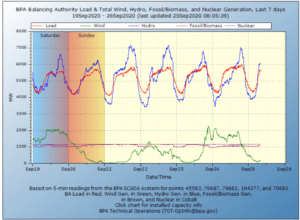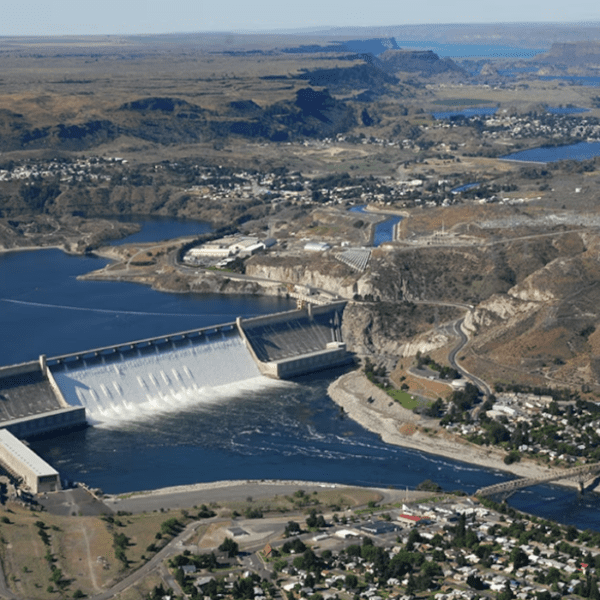The August 2020 grid emergency in California that resulted in utilities cutting power to hundreds of thousands of consumers put the spotlight on electric power reliability. In terms of delivering that required reliability, hydropower was at the top of the class. Large hydropower in California represents 16% of the state’s capacity, yet, when the grid was stretched to the max, hydro was providing as much as a third of the capacity in the critical peak evening ramp.
Why It Matters
What caused the state’s first capacity-related outages since the 2001 blackouts is not entirely clear. Some blame several circumstances coming together to form a “perfect storm” — hot and cloudy weather, a gas generator tripping offline, and the sudden loss of 1GW of wind. Others are attributing the issue to a complicated resource adequacy structure that is shared between the California Independent System Operation (CAISO) and the California Public Utilities Commission. With over 20 GW of weather-dependent resources sitting in the CAISO queue and the fact that climate change makes extreme weather more likely, one thing is clear: the U.S.’s western transmission grid needs more flexible resources like hydropower and pumped storage.
The Deep Dive
Everyday, CAISO must match supply and demand during the evening ramp when solar tapers off and air conditioning units are running full bore. This requires the grid operator to find 8GW of electricity supply every evening (the equivalent of turning on 7 nuclear plants in 3 hours!). CAISO usually meets this demand with flexible hydropower (both in-state resources and out-of- state imports) and natural gas.
On August 14, 2020, extreme heat and the loss of a large natural gas generator made the evening peak even more challenging. As CAISO operators struggled to meet demand, California hydropower owners were pumping over 5,700 MW of capacity onto the grid, enough to power around 4 million households. At the same time, CAISO was relying on about 7 GW of imports, much of which comes from hydro-dominated balancing authorities.
While CAISO was able to prevent a grid-wide blackout on August 14, it still had several more days of challenging conditions. On August 15, CAISO experienced significant and unexpected swings of wind output and the loss of another generator during the evening peak. This led the operator to again shed load to ensure the stability of the grid. In-state hydropower saw its largest peak output of the summer (over 6 GW) on August 18 when grid officials were once again seeing tight supply conditions. California hydro operators were working overtime to provide much needed flexible, clean power to the grid every day of the heat wave.
Below are just a handful of examples of how hydropower ensured reliability during the emergency conditions:
- Turlock Irrigation District (TID), which is connected to CAISO but runs its own grid, experienced its highest system peak on Monday, August 17. TID’s hydro fleet, led by the 203-MW Don Pedro generating facility, was able to meet this unprecedented demand without sacrificing irrigation water for their agricultural growers.
- Placer County Water Agency’s (PCWA)Middle Fork American River Hydroelectric Project is typically run to meet peak grid demands. In the summer of 2020, the project supplied 230 MW in the late afternoon/evening hours. From August 14 until the end of the summer, the Project’s five powerhouses ran 24/7 to supply real and reactive power to support the California grid during the heatwave.
- In anticipation of the heat wave, the California Department of Water Resources (DWR), which operates several hydro facilities, increased generation at its power plants and decreased pumping to the maximum extent possible while ensuring the safety of water infrastructure. The Oroville Power Complex was able to use additional storage in its afterbay to add an additional 250 to 350 MW of capacity into the grid during the super peak period. DWR coordinated with the Metropolitan Water District to increase water deliveries through the Devil Canyon hydroelectric power plant in San Bernardino. This change in operations provided an additional 80 to 150 MW of generating capacity to the California grid.
- Yuba Water Agency’shydro fleet provided 338 MW of peak time period power during the critical heat wave and responded to the August 17 CAISO request for more power by temporarily increasing its hydroelectric power generation by an additional 20 MW beginning on Tuesday, August 18. This increased the peak time power output to 358 MW of clean power to the grid providing power to as many as 350,000 homes. The Colgate Powerhouse is the perfect complement to wind and solar energy because it can ramp up and down in just 8 minutes to supplement the availability of solar and wind generation.
- San Diego County Water Authority’s40-MW Lake Hodges Pumped Storage project was operational during peak times to help offset the need for rolling blackouts. With estimates of 750 homes served per megawatt, that kept about 30,000 homes from losing power.
Additionally, almost 3 GW of pumped storage was working overtime to provide vital electrical power capacity to CAISO during the system peak. This included ramping up production from 3 p.m. to 7 p.m. and pumping at night and in low-demand parts of the day. These flexible operations allowed several natural gas plants to stay online which might have had issues with restarting.
Beyond California, hydro owners contributed substantial imports to help keep the system online. For example, between August 14 and August 19, the Bonneville Power Administration (BPA) used surplus power to supply nearly 65,000 megawatt-hours from the Federal Columbia River Power System to CAISO and other California load-serving entities. The chart below is a convincing visualization of BPA’s ability to use hydropower to continuously meet peak demand several days in a row.

What’s Next?
As California policymakers dig into the root causes of the blackouts, flexibility has emerged as an essential component to keeping the lights on as we rapidly decarbonize the grid. California is unlikely to achieve its reliability, clean energy, and affordability goals until CAISO’s markets more fully value the carbon-free grid flexibility provided by hydropower and pumped storage.
The National Hydropower Association is engaging with CAISO and other regional independent system operators to educate the value that hydropower and pumped storage provide. NHA is preparing an assessment of best practices to share with RTOs and ISOs in designing market rules that allow hydropower and pumped storage to fairly compete with other assets within competitive wholesale markets. The assessment will include information from hydro operators regarding the challenges they face when participating in wholesale markets, and their observations about whether RTO market rules in any way constrain the ability of hydro to fairly compete. Results will be used to guide NHA’s advocacy work.










